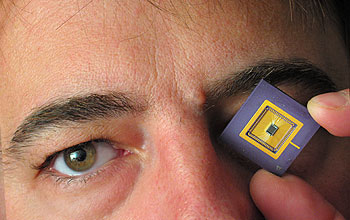Multimedia Gallery
The chip in this photo is a product of the team's related research at Carnegie Mellon.
Vladimir Brajovic and his collaborators at Intrigue Technologies are developing an image sensor that will approach the adaptive capabilities of the human eye. The chip in this photo is a product of the team's related research at Carnegie Mellon. Like the proposed chip, it is a computational image sensor that pre-processes an image before sending it to a computer, video screen or other outlet.
Credit: Vladimir Brajovic, Carnegie Mellon University and Intrigue Technologies
Images credited to the National Science Foundation, a federal agency, are in the public domain. The images were created by employees of the United States Government as part of their official duties or prepared by contractors as "works for hire" for NSF. You may freely use NSF-credited images and, at your discretion, credit NSF with a "Courtesy: National Science Foundation" notation.
Additional information about general usage can be found in Conditions.
Also Available:
Download the high-resolution JPG version of the image. (779 KB)
Use your mouse to right-click (Mac users may need to Ctrl-click) the link above and choose the option that will save the file or target to your computer.
Related story: New Image Sensor will Show what the Eyes See, and a Camera Cannot



